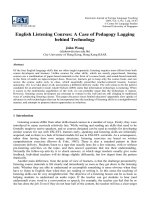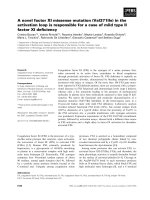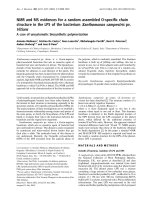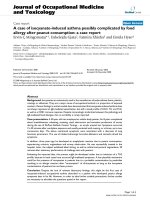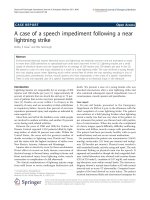Improving service quality a case of bao viet insuarance corporation
Bạn đang xem bản rút gọn của tài liệu. Xem và tải ngay bản đầy đủ của tài liệu tại đây (2.03 MB, 84 trang )
RESEARCH PROJECT
(BMBR 5103)
IMPROVING SERVICE QUALITY
A CASE OF BAO VIET INSURANCE CORPORATION
STUDENT’S FULL NAME
: NGUYEN THI NGOC BICH
STUDENT ID
: CGS00018496
INTAKE
: SEPTEMBER, 2014
ADVISOR’S NAME & TITLE : ASSOC.PROF.DR.PHAN DINH NGUYEN
December, 2015
ADVISOR’S ASSESSMENT
......................................................................................................................................
......................................................................................................................................
......................................................................................................................................
......................................................................................................................................
......................................................................................................................................
......................................................................................................................................
......................................................................................................................................
......................................................................................................................................
......................................................................................................................................
......................................................................................................................................
......................................................................................................................................
......................................................................................................................................
Advisor’s signature
ABSTRACT
Insurance is an arrangement or agreement that protects the financial well-being
of an individual, company or other entity in the case of unexpected loss. It is a form
of risk management primarily used to hedge against the risk of a contingent,
uncertain loss. Today, the insurance sector plays an important role in the
development of financial markets in the economy. Competition in the business, as
we know it, is dynamic and challenging. According to insurance market in Viet
Nam, many insurance enterprises are mainly competing by reducing premium or
increasing commission, but they lack of service quality improving strategies.
However, because the market competition develops rapidly, those advantages
are
no
longer
reliable
decisive
factor
in
competition for the insurance
enterprises. They realize that they cannot compete with each other solely on price,
but need to focus on their valued customers.
Therefore, service quality is an optimal factor and it becomes more and more
important for customers to select and use a service of the company. In line with the
market trend, Bao Viet Insurance Corporation has considered for improving
insurance service quality to meet customer satisfaction as the priority task of
company.
1
ACKNOWLEDGEMENTS
First of all, I express my deep gratitude to Mr.Phan Dinh Nguyen, my
supervisor. I would like to say thank for his guidelines and help for identifying
problems without which this work could not have seen the light of day.
Another thank you goes to my classmates, friends that give me support and
good comments about how I could improve my thesis. Their help have been
very important for motivating me to complete the thesis .
Finally I would also like to direct a special thank you to parents and other family
members who give me inspiration and support to work hard.
2
TABLE OF CONTENT
ABSTRACT ........................................................................................................... 1
ACKNOWLEDGEMENTS .................................................................................. 2
CHAPTER ONE: INTRODUCTION .................................................................. 7
1.1
Problem statement ............................................................................. 7
1.2
Objective of the study ........................................................................ 7
1.3
Ressearch questions ........................................................................... 8
1.4
Scope and methodology of study ....................................................... 8
1.5
Significance of study .......................................................................... 9
1.6
Structure of thesis .............................................................................. 9
CHAPTER TWO : LITERATURE REVIEW ................................................... 11
2.1
Service and characteristic of service ............................................... 11
2.1.1 Concept of service .......................................................................... 11
2.1.2 Characteristics of service ................................................................ 11
2.1.2.1 Characteristic of intangibility.................................................... 12
2.1.2.2 Characteristic of inseparability ................................................. 12
2.1.2.3 Characteristic of heterogeneity ................................................. 12
2.1.2.4 Characteristic of perishability .................................................. 13
2.2
Concept of quality ............................................................................ 13
2.3
Service quality and formation of service quality ............................ 13
2.3.1 Concept of service quality .............................................................. 13
2.3.1.1 Customers‟ Expectation of Service Quality............................... 14
2.3.1.2 Customers‟ Perception of Service Quality ................................ 14
2.3.2 Formation of service quality ........................................................... 14
2.4
Service quality measurement .......................................................... 17
2.4.1 The model originally provided a list of ten determinants of
service quality: ................................................................................................... 19
2.4.2 The model provided a list of 5 determinants of service quality:
....................................................................................................... 19
3
2.4.2.1 Tangibles .................................................................................. 20
2.4.2.2 Responsiveness ......................................................................... 20
2.4.2.3 Assurance ................................................................................. 20
2.4.2.4 Reliability ................................................................................. 20
2.4.2.5 Empathy ................................................................................... 20
2.5
Assessing Service Quality ................................................................ 21
2.6
Important of service quality dimensions......................................... 21
2.7
Methods to improve service quality ................................................ 22
2.8
Nature and characteristics of insurance business.......................... 23
2.8.1 Nature of insurance business ........................................................ 23
2.8.2 Characteristics of Insurance business ............................................. 24
2.9
Features of non-life insurance service ............................................ 25
CHAPTER THREE: RESEARCH METHODOLOGY .................................... 26
3.1
Qualitative research ......................................................................... 26
3.1.1 Design qualitative research............................................................. 26
3.1.2 Result of qualitative research. ........................................................ 26
3.1.2.1 Measuring quality of product .................................................... 26
3.1.2.2 Measuring quality of premium .................................................. 27
3.1.2.3 Measuring quality of employees/ agents ................................... 27
3.1.2.4 Measuring quality of claim process and indemnity activities .... 28
3.1.2.5 Measuring quality of customer service ...................................... 28
3.1.2.6 Measuring quality of distribution system .................................. 29
3.1.2.7 Measuring quality of advertising activities ................................ 30
3.1.3 Research model and scale of measurement ..................................... 30
3.1.3.1 Research model ........................................................................ 30
3.1.3.2 Scale of insurance service measurement ................................... 31
3.2
Quantitative research ...................................................................... 32
3.2.1 Design quantitative research ........................................................... 32
3.2.1.1 Research subject and Sample .................................................... 32
4
3.2.1.2 Questionnaire design. ............................................................... 32
3.2.2 Method of data analysis.................................................................. 33
CHAPTER FOUR: DATA PRESENTATION AND ANALYSIS .................... 34
4.1
Overview of Bao Viet Insurance Corporation ................................ 34
4.1.1 History and Development: .............................................................. 35
4.1.2 Network ......................................................................................... 36
4.2
Overview of insurance business ...................................................... 37
4.2.1 Insurance market ............................................................................ 37
4.2.2 Non-life insurance .......................................................................... 37
4.3
Summary of quantitative research result ....................................... 38
4.3.1 Sample description ......................................................................... 38
4.3.1.1 Gender ...................................................................................... 39
4.3.1.2 Age band .................................................................................. 39
4.3.1.3 Education level ......................................................................... 40
4.3.1.4 Type of insurance sector ........................................................... 40
4.3.2 Result of measurement scale testing ............................................... 41
4.3.2.1 Cronbach‟s alpha ...................................................................... 41
4.3.2.2 EFA factor analysis .................................................................. 41
4.3.2.3 Correlations analysis................................................................. 44
4.3.2.4 Multiple linear regression ......................................................... 45
4.4
Analyzing the status of actual service quality at Bao Viet Insurance
Corporation ......................................................................................................... 47
4.4.1 Reliability of insurance service ...................................................... 47
4.4.2 Service capacity of insurance company .......................................... 49
4.4.3 Responsiveness of insurance company ........................................... 52
4.4.4 Attractiveness of the insurance company ........................................ 55
CHAPTER FIVE : SOLUTIONS AND RECOMMENDATIONS. .................. 57
5.1
Solutions: .......................................................................................... 57
5.1.1 Improving reliability of insurance service ...................................... 57
5
5.1.2 Improving the service capacity of insurance company .................... 59
5.1.3 Improving the responsiveness of insurance company .................... 59
5.1.4 Improving the attractiveness of the insurance company .................. 60
5.2
Recommendations ............................................................................ 60
5.2.1 Recommendation for Insurance Supervisory Authority – Ministry of
Finance
....................................................................................................... 60
5.2.2 Recommendation for Vietnam Insurance Association (VIA) .......... 61
REFERENCE ...................................................................................................... 62
APPENDIX .......................................................................................................... 64
APPENDIX 1: DISCUSSION CONTENT (QUANTITATIVE RESEARCH) . 64
APPENDIX 2: QUESTIONNAIRE FOR CUSTOMERS ............................... 65
APPENDIX 3: TABLE OF VARIABLES WERE ENCODED ........................ 69
APPENDIX 4: CRONBACH ‘S ALPHA ........................................................... 70
APPENDIX 5: EFA FACTOR ANALYSIS ....................................................... 72
APPENDIX 6A: MULTI LINEAR REGRESSION RESULT .......................... 75
APPENDIX 6B : MULTI LINEAR REGRESSION RESULT (WITHOUT
THE CONVENIENT FACTOR) ........................................................................ 79
6
CHAPTER ONE: INTRODUCTION
1.1 Problem statement
Non-life insurance market in Vietnam has dramatically developed in recent
years. In Viet Nam, there are 29 non-life insurers on market and the dynamic
foreign insurance enterprises which contribute to increase competitiveness in the
insurance market.
The sinking position of the Bao Viet Insurance Corporation in the insurance
market needs to be concerned. These problems arise as a result of the corporation
has
been identified as not meeting customers „s demands and failing to reach
service quality such as poor returns on premiums, delays in processing claims and
confusing policy details. It is common to hear people complaining about the late
delivery of policy documents, renewal notices or even undue delay in responding to
customers‟ requests. Moreover, customers also complain about counseling products
by the sale persons who lack of expert knowledge about insurance products or
insurance sectors. These problems often expose in conflict as people are lured into
buying insurance policies that they do not properly understand.
With increasingly severe competition in market, the company needs to consider
its customer demands more than ever because the efficiency of insurance sector
depends upon how best it can deliver services to its target customers and how far
expectations of customers are met. In order to survive in this competitive
environment
and provide continual customer satisfaction, Bao Viet Insurance
Corporation‟s insurance services are now required to persistently improve the
quality of services. Therefore, improving service quality to meet customer
satisfaction which has become the priority goal of Bao Viet Insurance
Corporation on the market
1.2 Objective of the study
The general objective of the study seeks:
Measure and evaluate insurance service quality of BaoViet Insurance
Corporation.
7
Suggest solutions and recommendations to improve service quality of Bao
Viet Insurance Corporation.
1.3 Ressearch questions
The research will seek to provide answers to the following questions:
What is the current status of service quality of Bao Viet Insurance
Corporation?
What solutions and recommendations do Bao Viet Insurance Corporation
need to do for improving service quality?
1.4 Scope and methodology of study
2.3.1
Scope of study
- The study researches the assessment of customer about service quality of Bao
Viet Insurance Corporation.
- Data collected is through conducting survey with clients in Ho Chi Minh city.
Time of survey is in 2015
2.3.2
Methodology of the study
Utilizing the theoretical model of service quality combined with specific analysis of
insurance service, from which forming the research model to evaluate the insurance
„s service quality The process of research including:
Preliminary research is implemented through qualitative method with
technical discussions in group or duel. This research will be used to establish
preliminary scale of measurement of nonlife insurance „s service quality
Formal research: is done by quantitative method. Using the questionnaire to
investigate the assessment of clients of insurance service quality of Bao Viet
Insurance Corporation. This study aims to adjust and test the draft scale to
establish official scale about insurance service quality. Scale is assessed by
Cronbach alpha, EFA factor analysis , multi linear regression .This process
can explore what are factors of service quality?
After testing the scale will be used to analyze actual insurance service of Bao
Viet Insurance Corporation through descriptive statistic. This step aims to answer
8
the research question: “What is the current status of service quality of Bao Viet
Insurance Corporation?”
Based on the study results, I suggest solutions and recommendations to improve
service quality of BaoViet Insurance Corporation in the future. This process
answers the question: “What solutions and recommendations do Bao Viet Insurance
Corporation need to do for improving service quality?”
1.5 Significance of study
This study identifies service quality dimensions of Bao Viet Insurance
Corporation in order to develop strategies for improving the quality of service
delivery. This will enhance the company‟s competitive position in the
insurance sector and ensure survival of the company, especially in this era of
keen competition.
By improving service quality, Bao Viet Insurance Corporation can develop
customer service approach to deal with customers in order to avoid the tendency of
existing customers switching to a competing company. By identifying what
customers expect and perceive to be quality, the company can revise, redesign
its service operations and tailor them to meet the perceptions and expectations of
the customers. By this way, the delivered services will bring satisfaction to the
customers and make them stay while attracting new ones. The study will serve
as a guide for Bao Viet Insurance Corporation to develop policies which will
improve its overall service delivery, especially in areas where gaps between
expectations and perceptions are so wide to enhance customer satisfaction. This
will give Bao Viet Insurance Corporation a comparative advantage to become the
most favourite insurance company in Viet Nam „s insurance market.
1.6 Structure of thesis
The study is organized into five chapters as following:
Chapter One: Introduction
Chapter Two: Literature Review
Chapter Three: Research Methodology
9
Chapter Four: Data Presentation and Analysis
Chapter Five: Conclusions and Recommendations.
RESEARCH METHODOLOGY
LITERATURE REVIEW
DATA PRESENTATION & ANALYSIS
CONCLUSIONS &RECOMMENDATIONS
INTRODUCTION
Figure 1.1: Structure of Thesis
10
CHAPTER TWO : LITERATURE REVIEW
2.1 Service and characteristic of service
The world economy is increasingly characterized as a service economy. This is
primarily due to the increasing importance and share of the service sector in the
economies of most developed and developing countries. In fact, the growth of the
service sector has long been considered as an indicator of a country's economic
progress.
Along with the economic development, the service sector plays an important
role and it also contributes a big proportion of GDP of each countries. In Viet Nam,
total domestic product (GDP) in the first 6 months of 2015, an estimated 6.28%
increase over the same period of 2014.In the 6.28% growth of the whole economy,
service sector increased 5.90%, contributing 2.22 percentage points. This shows that
service sector occupies a key position in the national economy and it is an important
sector that contributes to economic growth.
2.1.1 Concept of service
In today‟s economy, service is everywhere and it has increased in importance
over the last decade with the advent competition. According to Kotler and Keller
(2009) define service as “Service is any act and performance that one party can
offer to another that is essentially intangible and does not result in the ownership of
anything”.
Zeithaml et al. (2006) define services as “Services are deeds, processes and
performances”.
According to Kotler & Armstrong (2004), “Services are activities or
benefits that businesses can offer to customers in order to establish, strengthen and
expand the long-term and cooperative relationships with customers”.
Almost same said by James Fitzsimmons (2008), “A service is a time perishable,
intangible experience performed for a customer acting in the role of co-producer”.
2.1.2 Characteristics of service
11
To identify a service, it is often based on four unique characteristics of a service
to be intangibility, heterogeneity, inseparability and perishability.
2.1.2.1 Characteristic of intangibility
It is considered to be a key characteristic of services and the most important
difference between goods and services, from which all other differences emerge
(Zeithaml et al., 1985) .It is defined as a certain things that cannot touch, see,
taste, hear or be aware of other goods (Groth and Dye, 1999). Intangibility is
the most important difference to distinguish between goods and services
(Santos, 2002). Due to the intangible characteristics of services that now very
difficult to determine the customer's perception of service, as well as their
appreciation about service quality is how (Parasuraman, Zeithaml and Berry,
1985) .
2.1.2.2 Characteristic of inseparability
It is taken to reflect the simultaneous delivery and consumption of
services and it is believed to enable consumers to affect or shape the performance
and quality of the service. It is shown that service provider perform service at the
same time with the service consumption of customer . Service providers cannot
hide any fault or deficiency of services (Ghobadian, Speller and Jones, 1994).
2.1.2.3 Characteristic of heterogeneity
This reflects the potential for high variability in the output of services (Zeithaml
et al., 1985). This is particularly problematic when the service is labor-intensive as
its performance and quality vary depending on the producer.
This feature is also known as the distinctiveness of the service. Accordingly,
the implementation of the service varies depending on how the service is provided,
location of service, targeted customer of service or time of service. This feature
is most recognized for service required high labor force. Requirement for
uniform quality of employees will be very difficult to ensure (Caruana & Pitt,
1997). The reason is that what the company intends to serve can be
completely different from what the consumer receives.
12
2.1.2.4 Characteristic of perishability
It means that services cannot be inventoried and saved for use in the future
(Zeithaml et al., 1985). Services are performances that cannot be stored. They
should be consumed when they are produced (Edgett and Parkinson, 1993). For
example, a hotel room that is not occupied for the day could not be saved and does
not generate revenue during that day. If a service is not used when available, then
the service capacity is lost (Edgett and Parkinson, 1993).
On the other hand, the hotel cannot supply hotel rooms for its customers when it
is fully occupied. Thus, the hardest task of services organizations is to match supply
and demand (Zeithaml et al., 1985). Sometimes demand exceeds maximum
available supply or demand exceeds optimum supply level. Some of the possible
strategies to match supply and demand include different pricing according to the
peak period, developing non-peak demand, developing reservation systems and
complementary services, utilizing part-time employees or third-parties, sharing
capacity, preparing in advance for expansion, etc. (Zeithaml et al., 1985).
2.2 Concept of quality
Quality is one of the things that consumers look for in an offer, which service
happens to be one (Solomon 2009). Quality can also be defined as the totality of
features and characteristics of a product or services that bear on its ability to satisfy
stated or implied needs (Kotler et al., 2002). It is evident that quality is also related
to the value of an offer, which could evoke satisfaction or dissatisfaction on the part
of the user.
2.3 Service quality and formation of service quality
2.3.1 Concept of service quality
Kasper and Gabbott (2006) define “Service quality is a complex and ephemeral
concept which refers to some attribute of what is offered, provided whereas
satisfaction or dissatisfaction refers to a customer‟s reaction to that offer”. Zeithaml
et al. (2006) refers service quality focuses specifically on dimensions of service.
13
“Service quality is the totality of features and characteristics of service that bear
on its ability to satisfy stated or implied needs”,(Kotler and Keller 2009).Gronroos
(1984) defined service quality perceived as a result of an evaluation process
when customers compare their expectations with the service they actually.
Customer expectation and perception are the two key ingredients in service
quality. Oliver (1980) posits that customers judge quality as “low‟ if performance
(perception) does not meet their expectation and quality as “high‟ when
performance exceeds expectations.
2.3.1.1 Customers’ Expectation of Service Quality
Customer expectations are beliefs about a service that serve as standards
against which service performance is judged (Zeithaml et al., 1993); which
customer thinks a service provider should offer, rather than on what might be
on offer (Parasuraman et al., 1988).This is influenced by their personal needs,
past experience, word-of-mouth and service provider‟s communications.
2.3.1.2 Customers’ Perception of Service Quality
Customers‟
perception
of
performance
is
what
they
experienced
(Parasuraman et al., 1988). Literature maintains that customers‟ total perception
of a service is based on their perception of the outcome and the process; where
the outcome is either value added or quality and the process is the role
undertaken by the customer (Edvardsson, 1998).The customer‟s perception of
quality of service is based on the degree of agreement between expectations and
experience (Kandampully, 1998).
2.3.2 Formation of service quality
The traditional models of service quality that assess the client's awareness about
service quality based on a number of factors or aspects,as service includes
a
complex mixture of explicit and implicit attributes. Service quality is not be viewed
as a discrete structure but a combination of several factors or aspects that they
have different content and nature Gronroos (1984) argues that the process of
awareness of customer service reflected in two aspects:
14
- Technical quality: the outcome dimension,or what the process leads to for
the customer as the results of the process.
- Functional quality: A process dimension, or how the service process
functions.
Customers perceive service quality in the two aspects: What do they
receive? How do they receive?How does service influence quality perception?
Depending on the evaluation of customers for service is good, neutral or bad.
Lehtinen and Lehtinen (1991) suggested that it is necessary to consider
service quality in the three aspects. The three aspects are:
- Physical quality: Includes equipment and physical environment.
- Interactive quality: is mainly derived from the matching between
communication styles of delivered service and the customer's style.
- Company quality: is mainly assessment of company‟ exterior form
Brady and Cronin (2001) also viewed service quality including three
dimensions, which has two dimensions same as Gronroos opinion of the
technical quality and functional quality .The third one is the service environment.
Each of these dimensions has three sub-dimensions and customers aggregate their
evaluations of the subdimensions to form their perceptions of an organization‟s
performance on each of the three primary dimensions.Customers establish their
service quality perceptions on the basis of an evaluation of performance at multiple
levels and combine these evaluations to arrive at an overall service quality
perception (Brady ,Cronin,2001)
15
Figure 2.1: Hierarchical model of service quality ( Brady ,Cronin,2001)
Dabholkar, Shepherd and Thorpe (2000) said that service quality is the
customer's overall evaluation, which based on different elements / attributes
related to service, thereby forming the overall assessment about service
quality, rather than a simple sum of the component elements. Multi-level
model is as follows:
Figure 2.2: The multilevel model of Retail Service Quality (Dabholkar,et al., 2000)
Among the models for measuring service quality, the most acknowledged
and applied model in variety of industries is the SERVQUAL (service
quality) model developed by Parasuraman et al. The model originally
provided a list of ten determinants of service quality: access, communication,
competence,
courtesy,
credibility,
reliability, responsiveness,
16
security,
understanding and tangibles. Further studies merged correlated variables and
reduced
the
determinants
into
five
consolidated
dimensions:
tangibles,
reliability, responsiveness, assurance and empathy as the instruments for
measuring service quality (Parasuramanet al., 1988; Zeithamlet al., 1990). The
SERVQUAL model assesses customer expectation and perceptions of service
quality by capturing the gap between expectation and experience.
2.4 Service quality measurement
The gap model of service quality:
The gap model (also known as the "5 gaps model") of service quality is an
important customer-satisfaction framework. In "A conceptual model of service
quality and its implications for future research" (The Journal of Marketing, 1985),
A. Parasuraman, VA Zeitham and LL Berry identify five major gaps that face
organizations seeking to meet customer's expectations of the customer experience.
Gap1: Customers‟ expectations versus management perceptions: as a
result of the lack of a marketing research orientation, inadequate upward
communication and too many layers of management.
Gap 2: Management perceptions versus service specifications: as a
result
of
inadequate Commitment to
service
quality,
a perception
of
unfeasibility, inadequate task standardisation and an absence of goal setting.
Gap3: Service specifications versus service delivery: as a result of role
ambiguity
and
conflict, poor employee-job fit and poor technology-job fit,
inappropriate supervisory control systems, lack of perceived control and lack of
teamwork.
Gap4: Service delivery versus external communication: as a result of
inadequate horizontal communications and propensity to over-promise.
Gap5: The discrepancy between customer expectations and their
perceptions of the service delivered: as a result of the influences exerted from the
customer side and the shortfalls (gaps) on the part of the service provider.
17
In
this case, customer expectations are influenced by the extent of personal
needs, word of mouth recommendation and past service experiences.
Figure 2.3: Model of service quality gaps by Parasuraman et al. (1985).
The first four gaps are identified as functions of the way in which
service is delivered from the service provider to the customer, while gap number
five is connected to the customer and as such is considered to be the truth of
service quality. Gap five is also the gap that the SERVQUAL instrument
influences. Edvardsson (1996) mentioned that it is important for a service
organization to define the level of quality at which to operate; he argued that it is
more relevant to speak of the “right quality” than of merely high quality.
The SERVQUAL scale which is also known as the gap model by Parasuraman,
et al. (1988) has been proven to be one of the best ways to measure the quality of
services provided to customers. This service evaluation method has been proven
consistent and reliable by some authors (Brown et al., 1993). They held that, when
18
perceived or experienced service is less than the expected service; it implies less
than satisfactory service quality; and when perceived service is more than expected
service, the obvious inference is that service quality is more than satisfactory (Jain
et al., 2004, p. 27). From the way this theory is presented, it seems the idea of
SERVQUAL best fits the evaluation of service quality form the customer
perspective. This is because when it is stated “perceived” and “expected” service, it
is very clear that this goes to the person, who is going to or is consuming the
service; who definitely is the consumer/customer.
2.4.1 The
model
originally
provided
a
list
of
ten
determinants of service quality:
Tangibles: Appearance of physical facilities, equipment, personnel, and
communication materials.
Reliability: Ability to perform the promised service dependably and
accurately.
Responsiveness: Willingness to help customers and provide prompt service.
Competence: Possession of required skill and knowledge to perform service.
Courtesy: Politeness, respect, consideration and friendliness of contact
personnel.
Credibility: Trustworthiness, believability, honesty of the service provider.
Security: the absence of doubt, economic risk, and physical danger
Access: Approachable and easy of contact.
Communication: Listens to its customers and acknowledges their
comments. Keep customers informed. In a language which they can understand.
Understanding the customer: Making the effort to know customers and
their needs.
2.4.2 The model
provided a list of 5 determinants of
service quality:
In 1985 Parasuraman, Zeithaml, and Berry suggested the most used and famous
model namedSERVQUAL. At first, they suggested ten dimensions for service
19
quality but after some initial study in1988, they reduced to five dimensions for
service quality model. The SERVQUAL model was based on difference between
perception and expectation of quality of service through five dimensions
2.4.2.1 Tangibles
They include physical aspects of the service such as physical facilities,
appearance of personnel, tools or equipment that is used to provide the
service, physical representations or other customers in the service facility.
2.4.2.2 Responsiveness
This factor concerns to what extent the employees are prepared to provide
service. This involves factors such as mailing a transaction slip immediately, calling
a customer back in short time and giving prompt service.
2.4.2.3 Assurance
This considers the knowledge and courtesy of employees as well as their ability
to convey trust
and
confidence.
The
assurance dimension
includes
the
following features: competence to perform the service, politeness and respect
for the customer, effective communication with the customer and the general
attitude that the server has the customer‟s best interest at heart.
2.4.2.4 Reliability
That is connected to the consistency of performance and dependability.
Here it is determined if the company give the service in the right way the
first time and keeps to its promises.
2.4.2.5 Empathy
It includes access, communication, understanding the customer. Caring and
individualized attention that the firm provides to its customers.
20
Figure 2.4: SERVQUAL model by Parasuraman et al. (1988).
2.5 Assessing Service Quality
Implementing and evaluating service quality is a very complex process,
because
of
the intangible nature of service and the difficulty in measuring
customers expectations and perceptions. Zeithaml and Bitner (1996) believe that
content and delivery of a service are essential factors for evaluating service
quality. While customers evaluate the quality of delivery, service providers
determine the content of the service. Edvardsson (1998) contends that the
concept of service should be approached from the customer‟s perspective.
Because the customer‟s total perception of the outcome is the service and the
customer outcome is created in a process where service is generated through that
process. Customers involvement in the service process is necessary, since they
are co-producer of service. The service process can be a delivery of service,
interpersonal interaction, performance or customer‟s experience of service
2.6 Important of service quality dimensions
The measurement of service quality relies upon an understanding of attributes
which contribute to consumer expectations and perceptions of service quality. These
attributes are assessed by customers and contribute meaningfully to a quality based
evaluation of the service provided. Knowledge of the dimensions of these attributes,
and possibly the ability to measure them, can yield an insight into more effective
ways of improving service quality. Indeed, Parasuraman et al. (1988) with their
21
work on SERVQUAL have sought to identify dimensions of service quality, such as
- reliability, assurance, tangibles, empathy and responsiveness (RATER).
Theoretically, this research offers a concept for explaining the varying
importance of service quality dimensions used by Parasuraman et al (1991). As
Gronroos (1984) has noted it is important for managers to understand how
individual facets of service quality are influenced, and how these facets are
perceived by customers. As studied by previous researches, the significance of
understanding of the service encounter from the consumer's perspective is an
essential element in developing and designing better service processes to enhance
overall quality (Bitner et al. 1994). Nevertheless, it is essential to recognize the
most important dimensions of the delivery of specific services and any strategies
that facilitate communication with customers leading to the identification of such
dimensions.
2.7 Methods to improve service quality
Quality service is a key element of a successful business. But many businesses
struggle to improve service and retain their customers. There are several methods to
improve quality service at the business, from having clearly defined and measured
service goals and motivating the employees, to using customer feedback and
updating the service tools to better serve customers.
Motivating the employees
Invest in service training, rather than a quality control department
Set up a new-employee initiation program
Tie employee‟s actions to the business‟s overall performance
Encourage employees to think of customer service as a "story" about the
business.
Give the employees service quality goals
Recognize and reward improvements in employee performance
Emphasize problem-solving
22
Teach the employees to overcompensate for any issues or complaints.
Listen to feedback from the employees
Measuring customer service performance
Determine how quickly to solve problems
Ask for personalized feedback from customers
Create a customer service survey.
Track any issues or complaints
Put processes in place to prevent issues from occurring again.
Defining service goals
Consider business type
Create a clear vision statement
Updating Quality Service Tools
Implement customer friendly technology
Don‟t neglect the social media.
2.8 Nature and characteristics of insurance business
2.8.1 Nature of insurance business
Insurance in law and economics, is a form of risk management primarily used to
hedge against the risk of a contingent, uncertain loss. Insurance is defined as the
equitable transfer of the risk of a loss, from one entity to another, in exchange for
payment. Insurance business is based on majority rule, it means insurance fund is
formed on the contributions of the many participants in insurance; this fund is used
to pay for a small number of participants as unfortunate loss. The greater number of
insurance participants, the greater the ability to compensate and business activities
of the insurance companies more efficient. Moreover, the insurance companies
23

